The quote in my title is from the Bulgarian-born artist Christo, who, with his wife Jeanne-Claude, erected 7,500 colorful “gates” draped in billowing saffron-orange fabric in New York City’s Central Park over 16 days in the dead of winter in 2005. Their work was surrealistic, too, as you see:
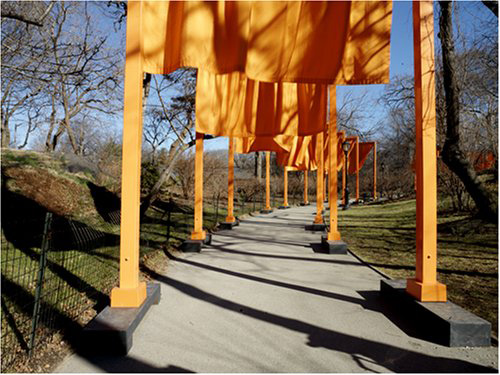
At 341 hectares (843 acres), Central Park is nowhere near the largest urban park in America. It’s certainly not the oldest; that would be a smaller park or two in St. Augustine, Florida, founded in 1565 — 60 years before Dutch settlers moved their cattle onto Manhattan Island. A year later, they bought the whole island from resident Indians and named it “New Amsterdam.”
Fueled by its port and shipments sent down the Hudson River via the Erie Canal that connected to the Great Lakes in the nation’s interior, lower Manhattan grew into a teeming, polyglot economic powerhouse. In 1811, city commissioners got around to drawing up a grid pattern of long north-south avenues and orderly east-west cross streets for mostly empty upper Manhattan. As a result of that plan, to this day people who can hardly find their way around middlin’-sized cities elsewhere navigate New York’s bustling thoroughfares with ease.
Multi-unit “walk-up” buildings rose along these arteries. Their apartments were eagerly rented by young couples, large immigrant families, and single “bohemians” such as landscape architect Frederick Law Olmsted and Calvert Vaux, a wealthy, dilettantish young architect from London. Together, they had just won a nationwide competition to design a grand urban park in the midst of it all.
Their “Greensward Plan’s” vision of a wild yet easily accessible park was Olmsted’s doing. Some of Central Park’s most cherished, manmade touches today, including its graceful bridges and arches, Victorian shelters, and ornate fountains, were Vaux’s. The end product, in which Manhattanites take fierce pride — and frequent respites — is nearly universally regarded as one of the most important landscaped green spaces ever created.
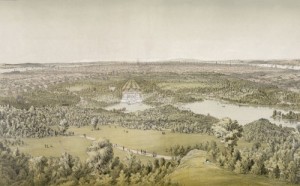
The area that became Central Park in 1860, three years into the park's creation. (Library of Congress)
Even before before Olmsted and Vaux moved to town, the city was gradually purchasing tracts of bramble bushes and copses and swampland that one report called a “pestilential spot where rank vegetation and miasmic odors taint every breath of air.”
The idea was Mayor Fernando Wood’s. He foresaw thousands of jobs for, and votes from, the unemployed resulting from development of the area. The mayor proved right on both counts.
Novelist Washington Irving and poet William Cullen Bryant, among others, sat on the committee charged with determining what to do with this scraggly burren.
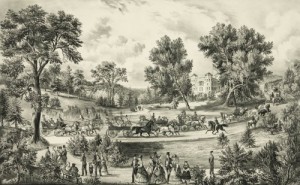
Over a 20-year period beginning in 1857, Olmsted and Vaux transformed the place into a playland of lawns, gardens, rock outcroppings, skating rinks, castles — even its own small zoo — New York’s first — which began as a small “menagerie” of exotic creatures. The two designers built in separate “circulation” systems for pedestrians, horseback riders, and “pleasure vehicles”: sporty horse-drawn phaetons in those days.
Four roads, now called “transverses,” that connected the city’s east and west sides were sunk below Central Park so as to be unobtrusive.
As the park neared completion, several Vanderbilts and other old-money aristocrats — as well as the nouveau riche — began a spate of “can you top this?” construction of fabulous city castles on Fifth Avenue alongside the park.
In 1872, building commenced on what would become the world’s largest art museum, the Metropolitan — or “Met,” as New Yorkers like to shorten it, on a parcel of land that intruded slightly into the rectangular park’s eastern perimeter. An entire “museum mile” of cultural institutions would march northward next to it thereafter.
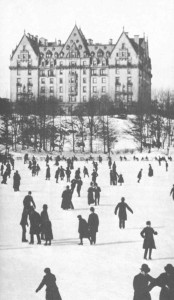
Skaters before The Dakota, which stood out alone and prominently in uptown Manhattan when this was taken in the 1880s. (Library of Congress)
Over on the west side of the park at 72nd Street rose the enormous — and posh — Dakota Apartments, a landmark building where, almost a century later, Beatle John Lennon and his wife, Yoko Ono, lived — and outside which Lennon would be murdered by an obsessed fan in 1980. The Dakota took its name from its remoteness as it appeared in 1884 on what then seemed like Manhattan’s equivalent of the Great Plains.
Many New Yorkers describe the delights, not just of skating or hiking or biking; skiing along the park’s paths in wintertime; dropping a coin into the hat of a talented busker or the fellow who bends balloons into giraffe shapes outside the Central Park Zoo; climbing schist and granite outcroppings; taking in a superb Shakespearian play or a free concert at the park’s open-air stages each summer; but also of just peering out the window of the Dakota or the equally massive, French Renaissance-style Plaza Hotel, where Rockefellers and other prominent New York families kept apartments, onto Central Park’s lagoons and trails, horse-drawn carriages and leaves that come and go and change with the seasons.
Some say 35 million out-of-towners also walk in or catch a carriage ride into Central Park each year.
I grew up five blocks from a heavily forested urban park just outside Cleveland, Ohio; Carol lived for a time in Philadelphia, whose Fairmount Park is filled with glorious statuary; we love the live oaks and Spanish moss in New Orleans’s City Park and San Francisco’s magical Golden Gate Park that stretches right into sand dunes on the Pacific. And we’ve walked Boston Common, the Revolutionary War-era assembly grounds that Olmsted’s sons, John Charles and Frederick Jr., touched up in the early 20th Century.
But to us, nothing compares with what Old Man Olmsted called Central Park’s “restorative powers” to energize the body and aesthetics to soothe the soul.
Disdaining the formal, fussy “gardening” techniques of the day, he and Vaux preserved many wild places and created buildings and manmade bodies of water to complement them. “Service must precede art,” Frederick Olmsted Sr. once stated, “since all turf, trees, flowers, fences, walks, water, paint, plaster, posts and pillars in or under which there is not a purpose of direct utility or service are inartistic if not barbarous.
“So long as considerations of utility are neglected or overridden by considerations of ornament,” he added, “there will be not true art.”
The juxtaposition of monolithic buildings surrounding such a serene urban setting accounts for part of Central Park’s allure. One literally moves down a few steps from the helter-skelter city of 8 million people into a cathartic, occasionally invigorating, sanctuary of calm.
There, it’s just you and the raccoons, ducks, geese, deer aplenty, red-tailed hawks — including those like “Pale Male” that are tame enough to have been named — and a few thousand other human strollers and runners and skaters, birders and dawdlers. It’s you and the mushrooms and berries and herbs, too, and 24,000 trees, including allées formed from 1,700 elms — the largest surviving stand in the nation — leading to the “Angel of the Water” in Bethesda Fountain.
“Refuge. Wonderland,” my friend and colleague and native New Yorker Adam Phillips calls Central Park. “Place of mystery and memories and green.”
“Central Park holds a unique place in my memory and imagination,” Adam told me. “Having grown up two blocks from this oasis, I proudly know it the way a farm kid knows his bit of earth. Every little patch has its memory and promise, and often its own bittersweet tale to tell, always in dialogue with, but never overpowered by, the varied skylines of Manhattan that ring the park.
It adds a special dimension to my experience of the Park — locals drop the word “Central” automatically — to know that it is an entirely created space. True or not [it’s not], urban legend says there were just sand dunes in that remote part of the island when Olmsted and Vaux planned their masterpiece.
They designed it so that each vista would end in the middle distance and be its own world — big enough to let the mind unfurl, but not so grand that one ever feels lost or swallowed up.
As anyone who has ever been to the Ramble [a 15-hectare woodland that Olmsted called a “wild garden,” laced with narrow trails] or Bethesda Fountain can attest, there are grand, altogether human and refined sights to enjoy. But they are always nestled into and graciously accommodated by the true nature that surrounds them. In a city where Culture often aggressively pushes Nature aside, statuary is an afterthought.
Time seems distant there; the present stretches out. It’s a place to watch the seasons go by, a place to be in one’s own thoughts. It’s a place to play, to people-watch, to snooze, to snatch a sense of verdant blessing away from the hordes. And of course it’s also a great place to kiss.
Whatever our reasons for going there, New Yorkers feel the pull of something benign and fundamental in Central Park, and share the uncanny sense that it is there for each of us alone, and all of us together.
As Olmsted and Vaux worked, out went the scrub brush and raggedy immigrant villages with names such as “Piggery.”
In, over the decades, came equally evocative, but more bucolic, names and places. The Bramble. Sheep Meadow. Trefoil Arch. The “Conservancy Water,” a pond on which to sail model boats. An Alice-in-Wonderland sculpture. Belvedere Castle — once a weather station, reopened by the Central Park Conservancy as a nature observatory — high on Vista Rock. The Swedish Cottage’s Marionette Theater. The Tavern on the Green, which went bankrupt last year but was once New York’s top-grossing restaurant. It’s now a visitor center and gift shop.
And the place for which tourists make a beeline: Strawberry Fields, a memorial to John Lennon designed by Bruce Kelly, the conservancy’s chief landscape architect. Lennon wrote the Beatles’ song by that name in recollection of idyllic moments playing in the garden of the Salvation Army’s Strawberry Field children’s home in London. And the name of Lennon’s signature ballad, “Imagine,” is depicted in mosaic form in the memorial.
Another attraction, the fourth carousel to stand in Central Park since the first — it was mule-powered — appeared in 1871, has no name, but its 57 hand-carved, painted horses and tinkly calliope supply an agreeable dose of nostalgia. And In 1956, children in Denmark paid for construction of a storytelling center, featuring a life-size bronze statue of Hans Christian Andersen, the Danish fable writer, on the west side of Conservatory Lake in the park.
Let us not forget the endlessly interesting people to be met and observed. Carol and I still chuckle over watching a young dog walker, no doubt employed by well-heeled residents of high-rise apartments on the park’s periphery, calmly maneuvering 12 mutts of all sizes and pedigrees through the tourists and vendors at Bethesda Fountain.
“You have people who are doctors and lawyers and presidents of corporations and a couple of homeless people and messengers and whatever,” said Lezly Zehring, a 70-year-old roller skater whom Adam Phillips interviewed in the park eight years ago. “Black, white, yellow, red — everybody is here. Nobody is competing with anyone else. . . . It’s a little microcosm of what the world should be like. It’s a community of love.”
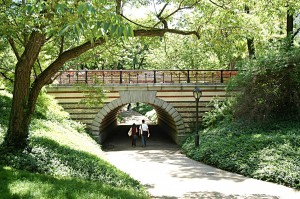
Folks like this would not have been walking here, certainly after dark, 10 or 15 years ago. (Lorax, Wikipedia Commons)
The Central Park Conservancy, a public-private management organization founded in 1980, along with the New York City Police, who designated Central Park as its own police district, faced something quite different from a community of love when they joined forces to change both the image and reality of the park, which had deteriorated into a debris-strewn, graffiti-sprayed, shabbily tended war zone of sorts where gangs of “wilders” preyed upon New York natives and visitors alike.
It took an especially heinous act in 1989 — the gang rape and nearly fatal beating of an investment banker known simply and forever only as “the Central Park Jogger” — to spur a concerted crackdown and clean-up. Five teenage suspects were arrested, tried, convicted, and imprisoned for the crime. Four were later freed after a convict confessed and was linked to it forensically.
By that time, Central Park had begun a remarkable transition into a model of harmony and vigilance; reported serious crime in the 22nd District — Central Park — declined by 72 percent between 1990 and 2010. New Yorkers tell me no one in his or her right mind would have walked Central Park at night in 1990 but that it’s commonplace now, thanks in no small part to three widely spotted species: police dogs, police horses, and their human handlers and riders.
Anyone who’s met a Yankees baseball fan knows that New Yorkers possess a swagger about their sports teams, their city’s 18,000 or so restaurants, its cultural attractions and vibrant neighborhoods — and their treasured Central Park. Having stepped out of the madding crowd and into that tranquil place for a dose of wonder and a breath of sanity on many occasions myself, I can’t say that I blame them.
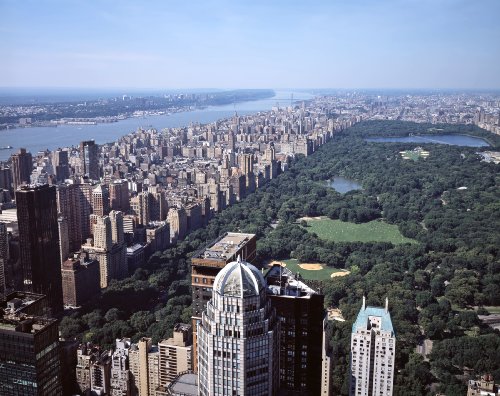
Central Park is a haven of green amid endless canyons of steel and concrete. (Carol M. Highsmith)
Ted's Wild Words
These are a few words from this posting that you may not know. Each time, I'll tell you a little about them and also place them into a cumulative archive of "Ted's Wild Words" in the right-hand column of the home page. Just click on it there, and if there's another word that you'd like me to explain, just ask!
Allée. An alley in a garden or park, formed by processions of trees on each side.
Bucolic. Rustic, restful.
Busker. A street entertainer who solicits donations from those who watch.
Copse. A small group of trees, often appearing in the midst of an otherwise barren location.
Dawdler. One who dawdles, or ambles slowly and idly.
Disdain. Contempt. The verb form means that one scorns another or believes someone or something is beneath his consideration.
Phaeton. In the days of horse-drawn carriages, phaetons were light, open conveyances, ideal for a fast trot. Phaeton automobiles that followed were fine touring cars.
Polyglot. An adjective describing a person or place of many languages. Immigrant neighborhoods in many big cities, for instance.
Schist. A coarse metamorphic rock. Under intense pressure and heat, schist can turn into smoother shale.


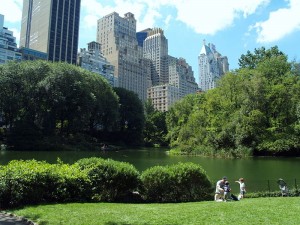
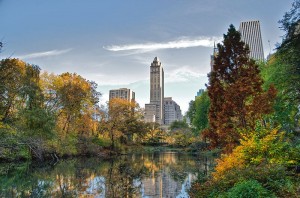
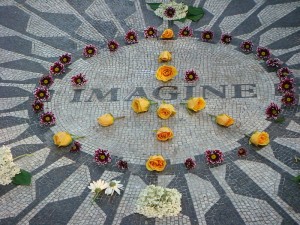

One response to “‘Most Unusual and Surrealistic’ Central Park”
great article, Olmsted was a visionary. I love Central Park, Boston Public Garden, and Golden Gate Park.